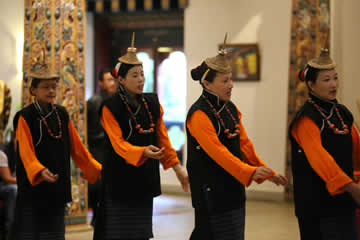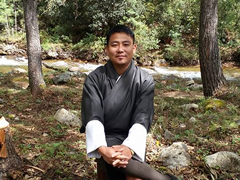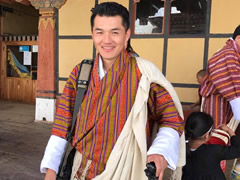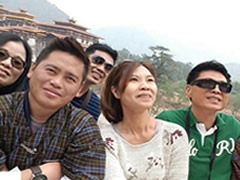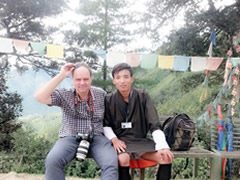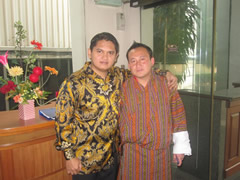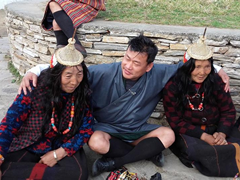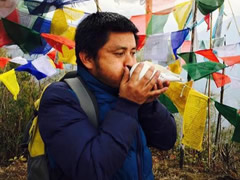Eight kind of Chortens / Stupa
Significance of eight kinds of Chortens / Stupas
Bhutan is adorned with Chortens or Stupas. It can be seen almost everywhere; on hilltops, in the valleys and even on the highways. Chorten is the oldest Buddhist religious monuments and was originally only a simple mound of mud or clay to cover relics of the Buddha. There are eight different kinds of Chortens in Tibetan Buddhism, each referring to major events in the life of a Buddha. It is rare to sight all the eight different kinds of Chortens together. There is one in Wangduephodrong, just a few metres away from the Wanduephodrang bridge.
- 1. The Lotus Blossom Chorten ( desheg Chorten)
This refers to the birth of the Buddha at a place called Lumbini. At birth Buddha took seven steps in each of the four directions- East, South, West and North. In each direction lotuses sprang, symbolising the four immeasurable of love, compassion, joy and equanimity.
The four steps of the basis of the Chorten are circular, and decorated with lotus-petal designs. Seven heaped lotus steps are constructed occasionally. This refers to the seven first steps of the Buddha.
- 2. The Chorten of Enlightenment ( Jangchuk Chorten)
This stupa symbolizes Buddha’s achieving enlightenment at Bodhgaya. It is here that the Buddha subdued all the evils and conquest worldly temptations and attacks manifesting in the form of Mara.
- 3. The Chorten of many doors (Choekhor Chorten)
The Chorten of many Doors is also known as the Chorten of many gates. After attaining enlightenment, the Buddha taught his first students in a deer park near Sarnath in Varanasi on the 4th day of the Sixth Bhutanese month.
The series of doors on each side of the steps represent the first teachings of the Buddha- the four noble truths, the six perfections and the noble eightfold path.
- 4. The Chorten of the decent from the God Relam (Lhabab Chorten)
At the age of 42, Buddha spent a summer retreat in Mout Meru, where his mother had taken rebirth. In order to repay her kindness he taught the dharma to his mother reincarnate. So in order to commemorate this event the local inhabitants built a Chorten on the 22nd day of the 9th Bhutanese month.
This stupa is characterised with a central projection at each side containing a triple ladder or steps.
- 5. The Chorten of great Miracles ( Yeadum Chorten)
This Chorten refers to various miracles performed by the Buddha when he was 50 years old. Legend claims that he overpowered Maras and heretics by engaging them in intellectual arguments and also by performing miracles.
This Chorten was raised by the Lichavi Kingdom to commemorate the event.
- 6. The Chorten of Reconciliation (Chotrul Chorten)
According to Lam Neten of Wangduephodrang this Chorten commemorated the Buddha’s resolution of a dispute among the Sanga or among the Buddhist community.
“A Chorten in this design was built in the kingdom of Magadha, where the reconciliation occurred.
It has four octagonal steps with equal sides.”
- 7. The Chorten of Complete Victory ( Namgyal Chorten)
When the Buddha was 80 years old, on the request of the king of the evils Buddha decided to attain the state of Parinirvana. But the devotees again requested the Buddha to still stay alive.
So, the Buddha then prolonged his life by three months.
In order to commemorate the prolonged life of Buddha this Chorten of complete victory was built.
It has only three steps, which are circular and unadorned.
- 8. The Chorten of Nirvana (Nyende Chorten)
This Chorten refers to the death of the Buddha, when he was 80 years old. It symbolises the Buddha’s complete absorption in to the highest state of mind.
It is bell shaped and usually not ornamented.
The Lam Neten of Wangduephodrang said that building a Chorten is considered extremely beneficial leaving very positive and accumulating merits in one’s life. “At times we should circumambulate the stupa with the inner thought of the teachings of the great masters,” he said.
Buddhists believe destroying or vandalising a stupa on the other hand is considered an extremely negative deed. According to the Lam Neten, such an action is believed to create massive negative karmic imprints leading to the massive future problems during the present stay and even after death.


